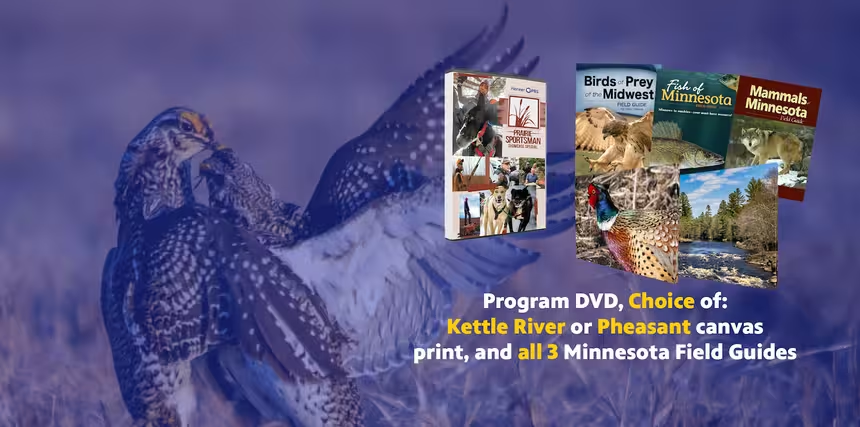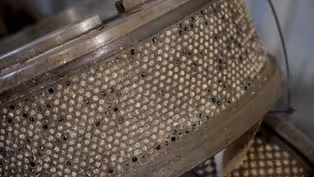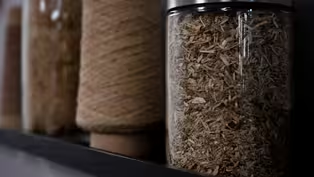Prairie Sportsman
Highway to Hemp
Clip: Season 16 Episode 5 | 9mVideo has Closed Captions
AURI researchers design hemp threads for road construction erosion-control mats.
AURI researchers in Waseca are developing hemp threads that could be used to make erosion control mats for the Minnesota Department of Transportation. The mats are typically made with plastic threads, but with increasing concerns about plastics in the environment, natural fibers are being investigated. Other promising hemp markets include building materials and auto parts.
Problems playing video? | Closed Captioning Feedback
Problems playing video? | Closed Captioning Feedback
Prairie Sportsman is a local public television program presented by Pioneer PBS
Production sponsorship is provided by funding from the Environment and Natural Resources Trust Fund, West Central Initiative, Shalom Hill Farm, and members of Pioneer PBS.
Prairie Sportsman
Highway to Hemp
Clip: Season 16 Episode 5 | 9mVideo has Closed Captions
AURI researchers in Waseca are developing hemp threads that could be used to make erosion control mats for the Minnesota Department of Transportation. The mats are typically made with plastic threads, but with increasing concerns about plastics in the environment, natural fibers are being investigated. Other promising hemp markets include building materials and auto parts.
Problems playing video? | Closed Captioning Feedback
How to Watch Prairie Sportsman
Prairie Sportsman is available to stream on pbs.org and the free PBS App, available on iPhone, Apple TV, Android TV, Android smartphones, Amazon Fire TV, Amazon Fire Tablet, Roku, Samsung Smart TV, and Vizio.

Prairie Sportsman Premium Gifts
Do you love the great outdoors, hunting, fishing, hiking and conservation? Consider becoming a friend of Prairie Sportsman to support it and receive gifts with your contribution.Providing Support for PBS.org
Learn Moreabout PBS online sponsorship- [Bret] Hemp is making a comeback in America.
While the fiber crop was widely grown here in the 1800s, its production declined after World War II with the advent of synthetics.
Then in 1970, the US government banned production of all cannabis species.
However, unlike its cousin marijuana, hemp is not a narcotic.
And in 2018, the US Farm Bill declared it a legal crop.
Today, with increasing concerns about plastics in our environment, natural hemp products are regaining their popularity.
They're being tested in a range of new products.
From building materials to erosion control mats for road construction.
(pensive music) AURI is a nonprofit research institute created to add value to Minnesota agriculture.
One of AURI's regional laboratories, the Bioindustrial Innovation Center in Waseca, is investigating hemp.
- In Minnesota, we are seeing a lot of hemp production really expand in the central part of the state.
It provides another opportunity for farmers.
AURI began working with hemp about five, six years ago.
And when we started to see that hemp explosion going on in Minnesota, one of the things we did to address that is how can we assist these growers in adding value and finding markets for the new hemp product.
Our focus was on the hemp fiber.
And we also have the capabilities to extract oil from the hemp seed.
But really, the initial work started with the fiber.
- [Bret] AURI received a grant from the Minnesota Environment and Natural Resources Trust Fund to develop hemp threads that could be used to make erosion control mats for the Minnesota Department of Transportation.
- The initiative or the LCCMR-funded efforts, one of their main focuses right now, and it has been, is how do you keep plastics out in the environment?
As you drive down the road and you see new construction going on, you will see erosion control mats rolled out along the side or you'll see erosion barriers to stop water runoff going into other sections.
Normally, these erosion control mats had a very fine filament of plastic that holds the straw together, that holds the wood mat together.
Well, what would happen is these products would degrade and do their job and the grass would go through it, you still had that plastic in the environment.
So now everything that they are doing is all burlap based.
They're not using any threads that are plastic.
The Minnesota Department of Transportation, they're very open to looking at new fibers, new opportunities to support Minnesota agriculture.
And that is one of the reasons we wanted to investigate, can we make a good thread out of hemp fiber?
One of the first things we did was to purchase a decorticator from Canada.
(machine whirring) What a decorticator does, it crimps that hemp stalk to break that outside shell off of it.
And then with a bunch of fingers that rapidly move, it liberates or separates what we call the bast.
It separates the bast from the hurd.
So that is the woody outside fraction that almost looks like little wood shaving.
Then you take that bast, the inner lining of the fiber, these fibers will get tore out and broken down into very fine strands.
And what the result is, here is your hemp bast.
And like you can see, it looks a lot like wool.
It's very durable, and that's what hemp is known for.
'Cause if you take a small fragment of it, twist it, this stuff will not pull apart.
And a lot of people will compare it to wool, and they'll say, "What is the difference?
Why don't you just use wool?"
And wool is an excellent fiber.
Cool in the summer, warm in the winter.
But the one thing that hemp offers different than wool is the sheer quantity of it.
Once we start growing hemp on various acres here in here in Minnesota, the tonnage is enormous.
We had three manufacturers manufacture an erosion control mat.
And what's interesting, they all look different.
Some are thicker, some are thinner.
But ideally you want the hemp hurd, the hemp fibers thin enough so that grass can grow through it.
The other product is using the hemp hurds, that woody fraction, in a hydroseeding mulch.
When they move soil, build a new ditch, or they have a slope that's highly erodable, susceptible to erosion, you know, they'll come along.
And in a water slurry along with seed, they'll blow this fiber and seed onto the soil.
what you want is a structure that sticks into the soil.
So when you have a rain event, it'll hold it.
MnDOT's conducting all the infield trials.
The reason they're doing all this testing of hemp fiber is so it is included in their book of standards.
MnDOT puts out a book of standards that if you're a contractor providing materials to MnDOT for any of their projects, it has to meet certain standards.
So whether it's erosion control, whether it's netting, whether it's a compost, it has to meet their standards.
And what we're doing, the collaboration between the two of us, is making sure hemp can fit into some of those situations.
And what that does, it grows the market.
It grows the need for hemp fiber.
We had asked MnDOT of the quantity of erosion control products that they utilize.
What is that compared to the rest of the state?
And it actually surprised me.
They utilize 10 to maybe 20% of erosion control products that are used in the total state.
So that means 90% to 80% of private or commercial contractors are using a lot more product than what MnDOT does.
If MnDOT says, "No more plastic netting, we're going to burlap or we're going to a hemp thread, or we're going to sisal," the industry will follow.
- [Bret] While currently Minnesota has fewer than 3000 hemp acres grown for food and fiber, erosion control materials could demand up to 20,000 acres, and there may be even more promising markets.
- I think the real opportunity is in the bio-construction market.
When we get our plants perfected, we're gonna see more bio-based insulation, we're gonna see more bio-based hemp construction panels.
more bio-based hemp construction panels.
So you're having basically a modular home, if you will, that's built from hemp.
There are many other things out there.
You have flooring that's being developed from hemp, two times harder than oak.
There's a wood preservative made from hemp to make wood last longer, which is very good.
And a whole host of other things that relates to plastics where automobile manufacturers can use this to replace synthetic petroleum plastic.
Farmers are cautious, and they should be.
They want to know particularly that there's a market there after they raise the crop.
The bottom line is, if hemp is going to be successful, it has to compete with corn and soybeans for net returns.
So, when growers look at this, that's the first thing they're gonna do.
They're gonna say, "Can I make as much income off of hemp as I can off of corn and soybeans?"
And if you're close, then you have a eureka moment and you're gonna have this crop propagated in Minnesota.
As we look at where we are in relationship to the rest of the world with this crop, I think we're behind a bit.
Europe is ahead of us.
They are well on their way to producing some very good bio-construction materials.
The plastic side of it is more mature there.
Once we get our things figured out here, we just got this massive property that exists in the USA where this crop could really take off and be part of so many ecosystems in the US 'cause it can grow in a lot of different areas.
It'll do well in many parts of the state of Minnesota.
So as a rotational crop, you're able to break up the rotation between corn and soybeans and introduce another crop that's really good in the entire rotation for the soil, for plant pests, even for weed control.
If we get it produced in volume, we'll have a very dynamic environment where we might look back and say, "Well, there's a lot of stuff that's being grown out here in the fields."
It's not just for food, it's for clothing perhaps, it's for your plastics, it's for your automobiles, it's for your home.
And that is the miracle of this crop because it's very, very versatile.
Video has Closed Captions
Clip: S16 Ep5 | 8m 8s | Bret Amundson visits Urban Ice Anglers on their goal of getting 10,000 youth on the ice. (8m 8s)
Video has Closed Captions
Clip: S16 Ep5 | 8m 9s | AURI showcases new Bioindustrial Innovation Center in Waseca. (8m 9s)
10,000 Youth Ice Anglers and Ag-Based Products
Preview: S16 Ep5 | 30s | Urban Ice Anglers gets kids outside; designing erosion-control mats; Bioindustrial Innovation Center (30s)
Providing Support for PBS.org
Learn Moreabout PBS online sponsorship
- Science and Nature

Explore scientific discoveries on television's most acclaimed science documentary series.

- Science and Nature

Capturing the splendor of the natural world, from the African plains to the Antarctic ice.












Support for PBS provided by:
Prairie Sportsman is a local public television program presented by Pioneer PBS
Production sponsorship is provided by funding from the Environment and Natural Resources Trust Fund, West Central Initiative, Shalom Hill Farm, and members of Pioneer PBS.




